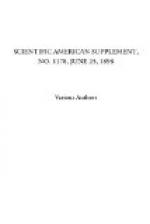In consideration of the importance of the questions involved, a short description of the tomb of Menes and of the objects found in it will certainly be of interest. The second part of De Morgan’s book, “Recherche sur les origines de l’Egypte,” which has just appeared, furnishes us with the facts concerning the tomb, and the objects found in the tomb I will describe from the originals in the Gizeh Museum.
The tomb consists of a large building, standing alone, measuring 54 X 27 m. (about 100 X 50 Egyptian ells), and built of burned brick. The outside walls were ornamented, as was usual in later Egyptian buildings, with pilasters composed of groups of smaller rectangular pilasters. It is the same motive so often to be observed in the sham doors in tombs of the old kingdom, and is really the most natural facade ornamentation for brick buildings, as it may be made by simply setting every alternate column of bricks forward or backward. The walls were, in addition, plastered. Back of the thick outside wall on each side lay a row of narrow rectangular rooms, formed by dividing a corridor by means of cross walls. Inside this surrounding row of rooms was the real tomb, a building with thick walls and five rooms in a row. The middle one of these rooms, noticeably larger than the others, is the real burial chamber. These five rooms were originally connected by doors which were afterward walled up. As to the roof, we can only make surmises, as the excavator has furnished us with no material on this point. The walls as they now stand are at the highest point about four meters high, and thus may form only the lower part of the building. Whether the roof was an arch of stone or simply of wood, is uncertain; but it seems to me probable that it was of wood. For the tomb contained a layer of ashes in which all the objects put in the grave with the dead man were found; and, assuming that the roof was of wood, it is possible that the roof was set on fire at the time when the tomb was robbed and that the ashes came from this fire. The explanation which the excavator gives of these ashes, that the body and the offerings were burned in the closed grave, hardly deserves consideration. In any case, the grave has been robbed and destroyed. That is shown by the fact that many pieces of funeral furniture, which originally could only have been put in the central rooms, were found partly broken in the outside rooms, or on the side toward the fields, the side most exposed to the attack of grave robbers.
The assumption that the grave has been robbed and intentionally destroyed agrees entirely with the fact that all the more valuable objects found in the grave were in fragments. But, fragmentary as they are, they are sufficient to give us a good idea of the art of the first period of the Egyptian kingdom, a period which is now most generally estimated to be five and a half millenniums before the present day (3600 B.C.) The skill with which ivory carving was done in that




